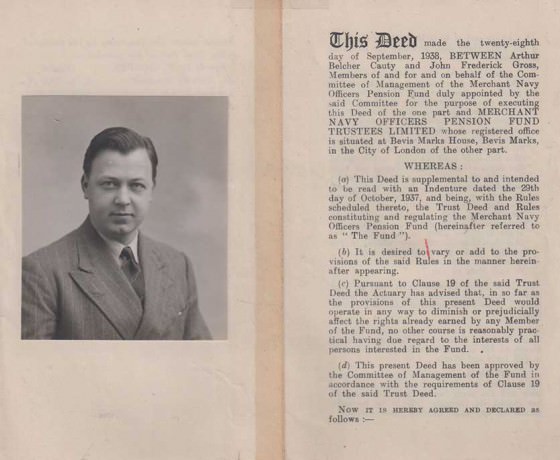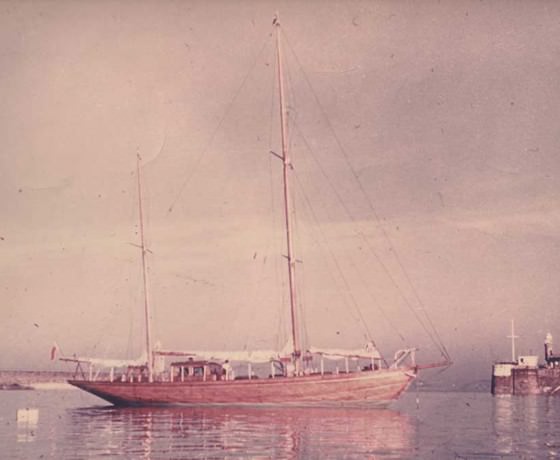History
“Two Scottish men went into a bar”, but the joke sadly ended there. The year would have been around 1929 and filled with the doom of the great depression and the bar would have been “The Mud Hook” in the town of Fairlie in Scotland.
The two brothers “Dickie” were about to sign up to an apprenticeship in ship building, which would last some 7 years, with one of the most celebrated ship designer and builder of our time William Fife III.
The apprenticeship would see the two brothers involved in the crafting and construction of many of the famous “Fife” yachts of this era and eventually lead to a rivalry so great that they would split and open two opposing ship yards and go head to head for a very special prize indeed. Acknowledgement from the master himself and the dragon’s tail.
The year now 1935, William Campbell sketches plans for a commission he has received. His largest commission to date, Cruinneag III is to be 3rd and largest in a series of yachts to be built for Mr. Robert Morton, a wealthy silk and textile importer from Glasgow. Undoubtedly influenced greatly by the success of William Fife & Sons located 30 miles away in Fairlie and the numerous busy ship building yards of the Clyde, Campbell set about designing Cruinneag III to the very highest standards and specifications demanded by his client.
What was unusual about Campbell’s commission was that Robert Morton was not interested in one of the fashionable day racers of the time or a weekend cruising yacht. He dreamed of seeing the world and he would spare no expense or improbable task to make sure his yacht was ready and able.
His yacht was to be built from ancient teak, more than two inch’s thick, hand chosen from his agents in Burma, and shipped to the small fishing village of Tarbert, Scotland for the build.
Cruinneag’s frames are solid oak, not steel, which was the material of the time and her fastenings a combination of bronze and black iron. Inside solid mahogany furniture and paneling highlighted the craftsmanship of the time and clever prism lighting and stain glass reflect the rich upholstery you would expect in a textile importers yacht.
Robert wanted a yacht in which just his wife and himself could reside and which they could sail with minimal or no crew. A yacht which would marvel onlookers and create majesty with her beauty. Robert Morton achieved his dream with the launch of Cruinneag III on that Tuesday in 1936.
80 years on and the quality and thickness of Cruinneag’s original teak deck and hull planking are the envy of modern yacht builders and are regularly recognized at regattas with awards in construction and elegance.
Legend of Tarbert
When Cruinneag III was launched in Tarbert, on June 2nd, 1936 she was the largest yacht built in the town to date and provided much attention.
In addition to all the official’s, press, craftsmen and women who came to witness the launch, free drams were provided to all the men of the village and lemonade provided to all the children from the local school which closed early that day so the kids could come witness the launch.
Today the original “Dickies” shipyard is now gone. Forced out of business in the late 50’s, the yard moved away from building pleasure craft and fishing vessels to chase government and ministry of defense contracts, which ultimately ceased and moved to more competitive locations. All that remains today at the location is the original launching winch, which guided so many great vessels in and out of the yard and a small plaque as testament to the machines quality and ultimately the quality of ship building in this area at that time. “Clyde Built – envy of the world”
Legend has it that the people of Tarbert were so proud of this beautiful yacht, that during World War II when other boats were being commissioned to join our war efforts, Cruinneag was carefully hauled out of the water and wheeled through the village and hidden in the local church yard, out of sight until after the war.
Although not proven, it remains a mystery where Cruinneag was during the war, while other ships were being pressed into service.
We would love to know more about this story and this period of Cruinneag’s history. If anyone can help uncover this fantastic tale or better still provide photographs, please get in touch!
One thing that is for certain, is she emerged late in 1944 unscathed and in Scotland. She had not been seen, used or dismantled, like so many other ships of this period, which were recycled for the war effort.
The war years demanded lead, copper and other rare materials for their efforts and many ships were sacrificed for the cause.
Cruinneag III stayed in Scotland for some 5 year following the end of the war, and little is known of her during this time. Her original owner sadly lost, she was taken to Portsmouth in the care of a broker to be sold. It was here, home to the British Submariner fleet that she was spotted by returning submariner, Lieutenant Commander George Christie and her future would be secured.
The Family Cruiser
In the 1950’s, Cruinneag III was bought by the Christie family of Glasgow where she remained for over 40 years. George Christie, a former submariner, was also fanatical about quality and cared for and preserved Cruinneag meticulously throughout his ownership of her. Cruinneag became the much loved family boat for the Christie’s who sailed her throughout the Clyde and on a number of occasions to the Mediterranean. She was kept on the dry for all but a few months every two years, during which time she was varnished and maintained by George and his carpenter Mate Ronnie.
In the 1950’s the deck house was added along with the wheel house giving much needed shelter and creating a fantastic ‘outdoors indoors’ space for passengers. Some minor modifications were made to the interior and a new engine installed in the 60’s but otherwise Cruinneag remained original throughout this period.
It was this incredible care and maintenance which had two real impacts on Cruinneag. She stayed in pristine original condition while she grew into a classic, yet remained relatively unknown as she was never ‘shown off’ in regattas or events of the times.
The Modern Years
The Christie family reluctantly sold Cruinneag in the late 1990’s and in the last decade she has been based in Loch Arrochar where her new owners ran an outdoors and adventure centre for young people. During this era she helped a lot of young people to experience sailing in such an amazing yacht and took part in the 3 peaks challenge. Quite a contrast to her formative years.
15 Minutes of Fame
Cruinneag made her television debut earlier this decade in the first series of the acclaimed BBC series Coast, where she sailed the BBC cameras and presenters in stunning conditions off the West Coast of Scotland. Footage of this is included in the movie in our Photo Album so a big thanks to the BBC for giving us their out-takes! Her hull at this time was still it’s original varnished state.
A Fitting Move
In 2008 Cruinneag III was sold again and is once again owned by the family that loved her so much for so long. This time it’s a new generation and a new start for the beautiful yacht under her new Skipper Nick, George’s Grandson.
Today
In 2008 her hull was painted white as can be seen in most of the recent photos and in 2011 her sail plan was returned to it’s original, getting rid of the oversized genoa, popular in the 1960’s and replacing with smaller stay sail/gib/gib top foresails.
In 2010 Cruinneag participated in the Classic Yacht regatta circuit and in 2011 she attended the Classic circuit once again but this time acting as mother ship and crew accommodation for the beautiful 1916 Herreshoff designed, New York 40 design Rowdy.
In November 2011 Cruinneag left her base in Tarragona and made passage to the Canary Islands where she successfully took part in the 2011 ARC. Crossing the Atlantic in 19 days, with no breakages, injuries or problems. Cruinneag’s crew of 6 and “Dandy” our dog arrived in St Lucia winning oldest yacht to compete and featured in three consecutive issues of Yachting World.
She then spent the winter cruising the Caribbean and participating in Classic Regattas in Antigua and St Barts before going on up the East Coast of the States again following the Panarai Regatta Circuit in Newport and Maine, before fleeing from Hurricane Sandy and finding a winter home and ideal location for an extended refit in Deltaville, Virginia.
This amazing journey, for which Cruinneag was designed and built, is a dream come true for skipper and owner, Nick Christie, who first sailed on Cruinneag III when he was 6 months old and his grandfather George Christie owned her.
If Sailing isn’t for you then follow our progress here online via our web site and now our new Facebook page. Be a part of this epic journey and get involved in preserving our maritime history. Send us your photos and come see us if we dock in your town.
But for the best experience book a trip and come be a part of history.
















